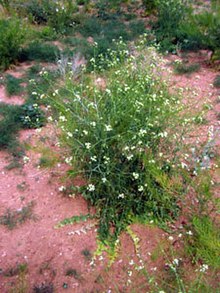| Sisymbrium altissimum | |
|---|---|

| |
| Scientific classification | |
| Kingdom: | Plantae |
| Clade: | Tracheophytes |
| Clade: | Angiosperms |
| Clade: | Eudicots |
| Clade: | Rosids |
| Order: | Brassicales |
| Family: | Brassicaceae |
| Genus: | Sisymbrium |
| Species: | S. altissimum |
| Binomial name | |
| Sisymbrium altissimum L. | |
Sisymbrium altissimum is a species of Sisymbrium. The plant is native to the western part of the Mediterranean Basin and is widely naturalized throughout most of the world, including all of North America. After maturity it forms a tumbleweed. Common names of the plant include Jim Hill mustard, tall tumblemustard, tall mustard, tumble mustard, tumbleweed mustard, tall sisymbrium, and tall hedge mustard.
Description
Tumble mustard forms an upright but delicate-looking plant, with slender, much-branched stems, growing up to 1.5 metres (5 feet) in height. Its stem leaves are divided into thin, linear lobes, while the basal leaves are broader and pinnately compound. The flowers are inconspicuous and only 6.4 millimetres (1⁄4 inch) wide. They have four usually yellow petals and four narrow, curved sepals. The seedpods are slender and long (5–10 centimetres or 2–4 in). The plant germinates in winter or early spring, with a lengthy blooming period. At maturity it dies, uproots, and tumbles in the wind, spreading its seeds.
Taxonomy
The common name 'Jim Hill mustard' is after James J. Hill, a Canadian-American railroad magnate, due to a farmers' tall tale about the seeds having been spread via his railroads.
Distribution and habitat
The plant is native to the western part of the Mediterranean Basin in Europe and Northern Africa and is widely naturalized throughout most of the world, including all of North America. It was probably introduced into North America as a seed contaminant of crops.
Ecology
The plant grows in soils of all textures, even sand.
Uses
The leaves are spicy enough to make wasabi but can also be mixed into salads and other dishes.
References
- NRCS. "Sisymbrium altissimum". PLANTS Database. United States Department of Agriculture (USDA). Retrieved 16 November 2015.
- Johnson, Eileen, ed. (1987). Lubbock Lake : late quaternary studies on the southern high plains. College Station: Texas A&M University Press. p. 29. ISBN 0-89096-321-5.
- ^ Royer, France; Richard Dickinson (1999). Weeds of the Northern U.S. and Canada: A Guide for Identification. The University of Alberta Press. p. 470. ISBN 978-1-55105-221-2.
- Laird R. Blackwell (2002). Wildflowers of the Eastern Sierra and adjoining Mojave Desert and Great Basin. Lone Pine Publishing. ISBN 978-1-55105-281-6.
- Nyerges, Christopher (2017). Foraging Washington: Finding, Identifying, and Preparing Edible Wild Foods. Guilford, CT: Falcon Guides. ISBN 978-1-4930-2534-3. OCLC 965922681.
External links
| Taxon identifiers | |
|---|---|
| Sisymbrium altissimum |
|
This Brassicales article is a stub. You can help Misplaced Pages by expanding it. |

